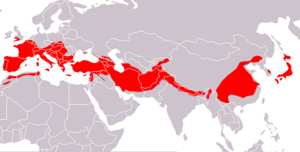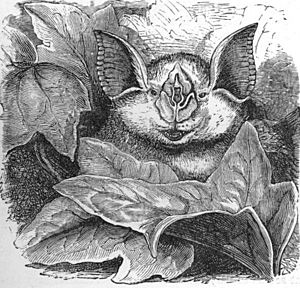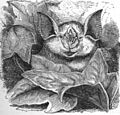Greater horseshoe bat facts for kids
Quick facts for kids Greater horseshoe bat |
|
|---|---|
 |
|
| Conservation status | |
| Scientific classification | |
| Genus: |
Rhinolophus
|
| Species: |
ferrumequinum
|
 |
|
| Greater horseshoe bat range | |
The greater horseshoe bat (Rhinolophus ferrumequinum) is a type of bat that eats insects. It belongs to a group of bats called Rhinolophus. You can find these bats across Europe, North Africa, and parts of Asia. It is the biggest horseshoe bat in Europe. This makes it easy to tell apart from other similar bats.
These bats usually stay in one area. They travel up to 30 kilometers between their winter and summer homes. The longest trip recorded was 180 kilometers. Greater horseshoe bats use special sounds to 'see' in the dark. This is called echolocation.
Contents
Description
The greater horseshoe bat is the largest horseshoe bat found in Europe. It has a special noseleaf. This noseleaf has a pointed top part. The bottom part is shaped like a horseshoe. This horseshoe shape helps the bat focus the ultrasound sounds it makes. These sounds help it 'see' its surroundings.
This bat also has unique teeth and bone structures. Its first premolar tooth on the upper jaw sticks out. In other horseshoe bats, this tooth is very small or missing. Compared to its relatives, this bat has shorter third and fourth bones in its wings. It also does not have a tragus, which is a small flap in the ear.
Greater horseshoe bats are usually between 57 to 71 millimeters long. Their tail is about 35 to 43 millimeters long. Their wingspan can be from 350 to 400 millimeters. Female bats are often a little bigger than males.
Their fur is soft and fluffy. The base of their hairs is light grey. The fur on their back is grey-brown. Their belly fur is grey-white. Young bats have a more ash-grey color. Their wing membranes and ears are light grey-brown. A greater horseshoe bat can weigh up to 30 grams. They can live for up to 30 years.
Where They Live: Distribution
The greater horseshoe bat lives in many places. Its home range stretches from North Africa and southern Europe. It goes through southwest Asia, the Caucasus, Iran, Afghanistan, Pakistan, and the Himalayas. It also lives in southeastern China, Korea, and Japan.
The farthest north they are found is in Wales. They also reach the southern parts of the Netherlands, Germany, Poland, and Ukraine. These bats usually live below 800 meters above sea level. But they can live up to 3,000 meters high in the Caucasus mountains. This depends on where they can find good places to rest and enough humidity.
How They Live: Ecology and Behaviour
Homes and Roosting Places
Greater horseshoe bats like to find food in pastures and woodlands. They also use Mediterranean shrublands and forests. In the northern parts of their range, they use warm underground spots. These can be natural caves or man-made places like old mines. They also use attics as summer homes.
When they live in buildings, certain things are important. They need to be close to good hunting areas. They also need underground spots for resting at different times of the year. These spots are also used for winter hibernation. The features of the building itself are also important.
Horseshoe bats sleep through the winter in cold underground places. They need specific temperatures and humidity levels. These needs can change based on their age, sex, and health. In warmer parts of their range, horseshoe bats are active all year.
They often travel 20 to 30 kilometers between their winter and summer homes. The longest trip ever recorded was 180 kilometers. Horseshoe bats also live in mountain forests in the Himalayas. They rest in caves, old temples, and ruined buildings. They often huddle together in tight groups.
What They Eat and How They Hunt
Greater horseshoe bats mostly eat lepidopterans, which are moths. Moths make up about 41% of their diet. They especially like noctuid moths. For example, they hunt the lesser wax moth. They find this moth by listening for its high-frequency mating call.
Beetles make up about 33% of their diet. They often eat dung beetles and cockchafers. One important dung beetle they eat is Aphodius rufipes. These beetles live part of their life in cow pats. The cow pats are food and home for the beetle larvae. Up to 100 larvae can be found in one cow pat. Adult beetles are most common in August. This is when young bats start their first hunting flights.
The rest of their diet includes Hymenoptera (like wasps and bees) and Diptera (flies). They also eat cave spiders.
Female bats raising young usually hunt within 4 kilometers of their maternity roost. This is because the mothers and young cannot travel far. In late August and September, bats eat craneflies. This helps them get fat before they hibernate for winter. Breeding females eat beetles from April to June. They eat moths from June to August.
The greater horseshoe bat leaves its home at dusk. It flies slowly with fluttering movements and short glides. It usually flies between 0.3 and 6 meters above the ground. They do not hunt much during wet and windy weather. They hunt in open areas like hillsides and cliff faces. They also hunt in gardens. They find insects from a resting spot and then fly to catch them. These bats can pick up food from the ground while flying. They also drink water during low-level flight or while hovering. Bat colonies in England hunt within 8 to 16 kilometers of their home.
Life Cycle and Reproduction
Female bats can have babies when they are three years old. Males can mate when they are two years old. Some females might not have babies until they are five. Most mating happens in the fall. But some mating also happens in the spring.
Scientists have studied how these bats reproduce. During mating season, females visit males that are resting in small caves. A male bat may mate with several females. However, some female greater horseshoe bats visit and mate with the same male year after year. This shows they can be loyal to one partner. Interestingly, female bats that are related sometimes share male partners. This might help make their colony stronger.
Males have different levels of success in having babies. But within one year, most males have a similar chance. Over several years, some males become much more successful. This is because they keep having babies year after year.
Females raise their young together in special maternity roosts. They often return to the same places where they were born to have their own babies. Each year, a female usually has one baby. Most young bats are born in June or July. When they are seven days old, young bats can open their eyes. They can fly by their third or fourth week. Young bats can leave the roost when they are seven or eight weeks old.
Status and Conservation
The greater horseshoe bat is listed as "Least Concern" by a group called the IUCN. This means they are not in immediate danger of disappearing. They have a large range. Even though their numbers have dropped in some areas, they are still common and stable in others.
However, the total number of greater horseshoe bats is going down. They are not common in many parts of their range. But they seem to be common in parts of southwest Asia and the Caucasus. In some northwest European countries, their numbers seem to be stable or even growing. Less is known about bat numbers in other parts of Europe. They are now gone from Malta.
Major threats to these bats include:
- Their homes being broken up or separated.
- Changes in how forests and farms are managed.
- Loss of insects because of pesticides.
- Being disturbed or losing their underground homes and attics.
In South Asia, cutting down forests for logging or farming also threatens them.
Status in Britain
This bat species is rare in Britain. It is found in only a few places. You can see where they live on the National Biodiversity website here. Their breeding sites include Brockley Hall Stables near Bristol, Iford Manor near Bath, and Littledean Hall in the Forest of Dean.
Their winter hibernation sites include Banwell Caves and Compton Martin Ochre Mine in the Mendip Hills. Also, Chilmark Quarries in Wiltshire, and Combe Down and Bathampton Down Mines near Bath. In Dorset, they rest at Bryanston, Creech Grange and in Belle Vue Quarry. They are also found at Berry Head in Devon. There is a monitored roost site at Woodchester Mansion in Stroud. They also live in Wales, including at Felin Llwyngwair, which is a SSSI.
The greater horseshoe bat has disappeared from more than half of its old home range in the United Kingdom. Only about 1% of the population is left. Like all horseshoe bats, they are easily bothered by disturbances. They are also threatened by the use of insecticides. Changes in farming methods also reduce the number of beetles they eat.
There are seventeen recorded bat species in Britain. The greater horseshoe bat is one of the rarest. There are currently 35 known maternity and all-year roosts. There are also 369 hibernation sites. Current estimates say there are between 4,000 and 6,600 individual bats.
Greater horseshoe bats have declined for many reasons. These include the use of farm chemicals, especially Ivermectin. They also suffer from losing their homes and changes in farming methods. Ivermectin kills insect larvae. This means less food for the bats. This makes them travel farther and face more dangers.
Their homes are lost mainly because there are fewer hedgerows and deciduous woodlands near pastures. Modern farming has reduced cattle grazing. This has hurt the bats. Cow dung used to attract insects and support insect populations. This gave the bats a steady food supply.
Images for kids
See also
 In Spanish: Murciélago grande de herradura para niños
In Spanish: Murciélago grande de herradura para niños








